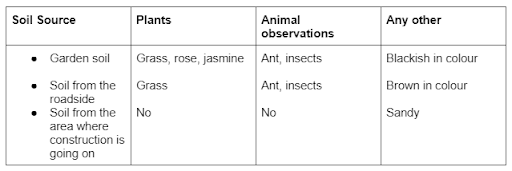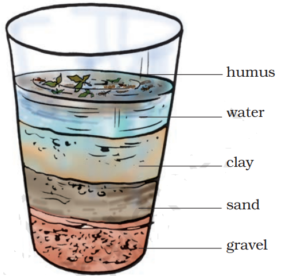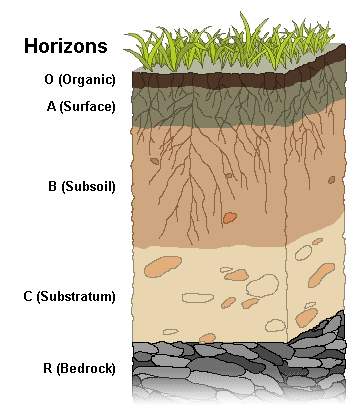SOIL for Class 7 SCIENCE
Introduction
Hamare chapter ka name hai soil, matlab ‘mitti’. Soil toh hum sabhi ne dekhi hai aur hum sab iske baare mein kuchh na kuchh to jante hi hai, eg- hum jante hai soil plants ko grow karne ke liye use ki jati hai. Toh iss chapter mein hum iske baare mein detail mein padhenge. Iss chapter mein hum soil ke types, iski profile, iski properties, water absorption, crops, etc. ke baare mein padhenge.
Let’s understand some basic things about soil
Soil ek bahut important natural resource hai, yeh earth crust ki uppermost layer hoti hai aur blackish-brown colour ki hoti hai. Soil bahut saare functions perform karti hai jaise yeh plants ko water aur nutrients supply karti hai taki woh achhe se grow kar sake. Soil mein bahut saare organisms bhi rehte hai toh soil kuchh organisms ko shelter bhi provide karti hai. Soil agriculture ke liye bahut important hai aur agriculture hamare liye bahut important hai kyonki agriculture ki wajah se hi sabko food, clothing aur shelter mil pata hai. Soil hamari life ka inseparable part hai. Ab hum iske baare mein thoda detail mein padhte hai.
Soil Teeming With Life
Soil mein air, water and minerals present hote hai aur isme bahut saare living organisms jaise fungi, bacteria, insects, etc. bhi rehte hai. Kuchh organisms toh itne chote hote hai ki hum unko naked eyes se dekh bhi nahi sakte. Earthworm bhi aisa hi ek organism hai jo soil mein rehta hai, yeh soil se apna food leta hai, soil mein hi apna waste release karta hai aur soil ki fertility ko increase karta hai.
Ab hum kuchh places ke soil samples lete hai aur observe karte hai unme kya kya present hai.

Soil Profile
Sabse pehle hum dekhte hai ki soil kaise banti hai aur fir janege ki usme kya kya present hota hai.Wind, water aur climate ke action ki wajah se rocks ka breakdown hota hai jisse soil banti hai, iss process ko hum weathering kehte hai. Jis bhi type ke rocks se soil banti hai, soil bhi usi type ki hoti hai. Ab hum dekhte hai ki soil mein koun- kounsi layers hoti hai.

Agar hum thodi soil lenge aur usko achhe se stir karke water mein dissolve karke kuchh time ke liye undisturb chod denge toh different size ke particles ki different layers ban jati hai. Yeh separate hui layers hum upar figure mein dekh sakte hai. Inn layers mein sabse upper layer humus hoti hai.
Soil mein jo rotting dead material present hota hai usko humus kehte hai. Yeh soil ki sabse upper layer hoti hai.
Soil Profile- Soil ki different layers ke through jo vertical section hota hai usko soil profile kehte hai. Soil ki har ek layer ka texture, colour, depth, chemical composition different hota hai. Inn layers ko hum horizons bhi kehte hai. Yeh layers hamein usually dikhayi nahi deti, hamein mostly soil ki top layer dikhti hai. Soil ki inner layers dekhne ke liye hamein soil ko dug karna padta hai, ya fir koi well dig karte huve, steep river bank ya kisi hill roads ki side par bhi hum soil ki inner layers ko dekh sakte hai. Ab hum soil ke different horizons ke baare mein padhenge.
A- Horizon or Topsoil
Yeh soil ki uppermost layer hoti hai aur isme humus aur minerals jyada amount mein present hoti hai isliye iska colour dark hota hai. Yeh layer plants ko nutrients provide karti hai aur unki growth mein help karti hai. Yeh layer soft aur porous hoti hai aur jyada water retain kar paati hai. Yeh layer bahut saare living organisms jaise worms, rodents, etc. ko shelter provide karti hai aur small plants ke roots toh totally topsoil mein embedded hote hai.
B- Horizon or Subsoil
Yeh soil ki middle layer hoti hai aur topsoil ke bilkul niche present hoti hai. Isme less amount of humus hota hai lekin minerals jyada present hote hai. Yeh layer generally topsoil ke comparatively hard aur compact hoti hai. Iss layer ka colour topsoil se light hota hai kyonki isme humus less amount mein hota hai.
C-Horizon
Yeh soil ki third layer hoti hai aur subsoil ke just niche present hoti hai. Iss layer mein small lumps of rocks present hote hai.
Bedrock
C-horizon ke niche ek aur layer present hoti hai jisko hum bedrock kehte hai. Yeh soil ki last layer hai aur isko spade se dig karna bahut difficult hota hai.

Ab hum different types ki soil ke baare mein padhenge.
Soil Types
Jaisa ki hum sab jante hai ki weathering of rocks se soil banti hai aur soil kaisi hai yeh uski parent rock par depend karta hai.
Soil, rock particles aur humus ka ek mixture hai. Isme different particles jaise sand, clay, etc. present hote hai aur yeh particles jis proportion mein present hote hai uske basis par hum soil ko classify karte hai. Ab hum different type ki soil ke baare mein padhenge.
1. Sandy soil
Sandy soil mein big particles greater proportion mein present hote hai. Iske particles ka size bada hota hai isliye yeh ek doosre ke paas fit nahi ho paate aur inke particles ke beech mein large spaces hote hai jo air se filled hote hai, isliye sand well aerated hoti hai. Iske particles ke beech mein space hone ki wajah se yeh water ko hold nahi kar pati.
2. Clayey soil
Clayey soil mein fine particles higher proportion mein present hote hai. Iske particles comparatively small hote hai aur air ke liye bahut less space hota hai aur less space ki wajah se yeh water hold kar pati hai. Yeh water hold karke rakhti hai isliye yeh heavy hoti hai.
3. Loamy soil
Loamy soil mein large aur fine particles equal amount mein present hote hai. Yeh sand, clay aur silt ka mixture hoti hai. Isme humus bhi present hoti hai aur plants ki growth ke liye iski water holding capacity bahut achhi hoti hai.
Silt- Silt bhi ek type ki soil hoti hai iske particles ka size sand aur clay ke particles ke size ka intermediate hota hai.
Soil particles ka size uski properties ko bhi influence karta hai. Ab hum soil ki properties ke baare mein padhenge.
Properties of soil
Soil particles ke different sizes ki wajah se iski different properties hoti hai ab hum inn properties ke baare mein padhenge.
Percolation rate of water in soil
Yeh soil ki ek aisi property hai jisme soil water ko khud mein se pass hone ko allow karti hai. Different types of soil mein rate of percolation different hota hai. Kuchh soils water ko absorb kar leti hai aur kuchh khud mein se flow karne deti hai. Rate of percolation calculate karne ke liye hum niche diye gaye formulae ko use kar sakte hai-
Ab hum ek sample ka percolation rate calculate karke dekhte hai. Iss 200 ml sample ne percolate karne ke liye 20 minutes liye.

Moisture in soil
Soil mein kuchh amount of water present hota hai jisko hum moisture kehte hai. Har ek type ki soil mein moisture present hota hai, even dry soil ko bhi jab hum air mein laate hai usme bhi kuchh moisture aa jata hai. Plants ki proper growth ke liye soil mein moisture hona bahut important hai kyonki roots soil se hi moisture absorb karti hai.Kya aapne kabhi notice kiya hai ki farmland ki soil daytime mein shimmer karti hai? Aisa kyo hota hai?
Jaisa ki hamein pata hai ki soil mein water present hota hai aur daytime mein sunlight ki wajah se yeh water evaporate karna start kar deta hai aur water vapour mein convert hone lagta hai. Yeh water vapour jab sunlight ko reflect karta hai toh shine karta hai isliye soil ke upar ki layer shimmery dikhayi deti hai.
Absorption of water by soil
Soil mein moisture hota hai lekin fir bhi yeh water absorb kar sakti hai. Different kinds of soil different amount of water absorb karti hai. Eg- Clayey aur loamy soil jyada porous hoti hai isliye jyada amount of water retain kar sakti hai. Soil ki bhi water absorb karne ki ek limit hoti hai aur soil ki iss water absorb karne ki capacity ko hum absorption percentage kehte hai.

Soil and Crops
India ke different parts mein different types ki soil present hai. Kuchh parts mein clayey soil hoti hai, kuchh parts mein loamy soil hoti hai aur kuchh parts mein sandy soil hoti hai. Soil profile ko kuchh climatic factors jaise wind, rainfall temperature, light aur humidity affect karte hai aur soil structure mein change laate hai. Climatic changes aur soil components par hi depend karta hai ki kis jagah kounsi crop grow ki ja sakti hai.Eg- Clayey aur loamy soil ki water retaining capacity achhi hoti hai isliye cereals jaise wheat, gram, etc. grow karne ke liye suitable hoti hai.
Paddy ki crop grow karne ke liye clay aur organic matter rich soil chahiye hoti hai.
Lentils aur other pulses ke liye loamy soil needed hoti hai kyonki isme water easily drain ho jata hai. Niche table mein hum kuchh crops ke name dekh sakte hai aur yeh bhi jaan sakte hai ki woh kis type ki soil mein grow hoti hai.

Soil Erosion
Wind, water ya ice ke action ki wajah se land ke upper surface ki fertile layer remove ho jati hai, isko hum soil erosion kehte hai.Plants aur trees ki roots soil ko tightly bind karke rakhti hai aur inke removal ki wajah se soil loose ho jati hai aur wind, water, etc. ke action ki wajah se move kar jati hai.
Aaj- kal population ke increase ki wajah se land ki jyada jarurat hai iske liye log forest trees aur plants ko cut kar rahe hai, itne large scale par trees aur plants ki cutting ko hi hum deforestation kehte hai.
Soil erosion ko prevent karne ke liye hamein trees ko cut nahi karna chahiye aur jyada se jyada trees plant karne chahiye.
POINT 1
Soil: Soil is the loose material present on top of Earth’s crust and covers most of the land.
Percolation: Percolation is the process of a liquid slowly passing through a filter.
Weathering: Weathering is the breaking down or dissolving of rocks and minerals on Earths surface.
Soil profile: Soil profile is defined as the vertical section of the soil from the ground surface downwards to where the soil meets the underlying rock.
Deforestation: Deforestation can be defined as the large-scale removal of trees from forests (or other lands) for the facilitation of human activities.
SUMMARY
1. Soil is important for life on the earth.
2. Soil profile is a section through different layers of the soil, Various layers are called horizons.
3. Soil is of different types: clayey, loamy and sandy.
4. Percolation rate of water is different in different types of soil. It is highest in the sandy soil and least in the clayey soil.
5. Different types of soils are used to cultivate different types of crops. Clay and loam are suitable for growing wheat, gram and paddy. Cotton is grown in sandy loam soil.
6. Soil holds water in it, which is called soil moisture. The capacity of a soil to hold water is important for various crops.
7. Clayey soil is used to make pots, toys and statues.